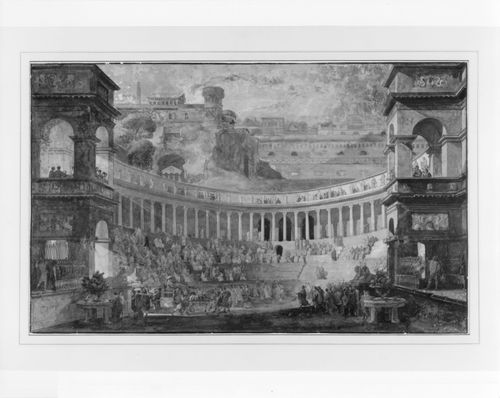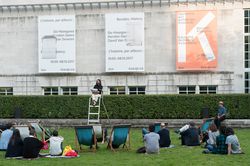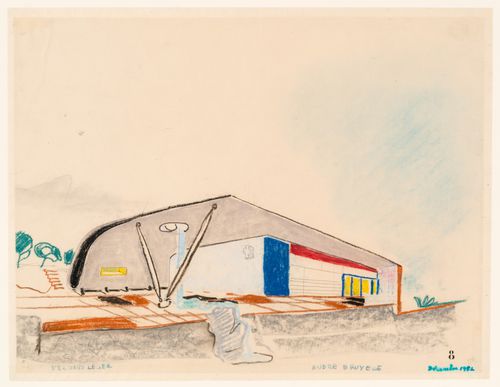Project
AP178.S1.1989.PR03
Description:
This project series documents the plano de Doedijnstraat, the residential settlement in Schilderswijk, The Hague, The Netherlands. While the records were held in the office’s archives this project was assigned the number 63/80. The office assigned the date 1989 for this project. In 1993 Siza was awarded the Berlage Prize for this residential project of 238 flats. The project was part of an urban renewal program in The Hague for which Siza had already worked on other projects: the urban plan for Deelgebied Zone 5, Schilderswijk-West and Punt en Komma social housing; the housing and shopping complex in Schilderswijk; and the Van der Vennepark. Documenting this project are sketches, studies, elevations, plans and details. Textual documentation includes correspondence, such as letters to and from Siza, letters to Jeoron Geurst (from the associated architectural firm Geurst & Schulze architekten), and letters to and from project architect Carlos Castenheira. Furthermore, there is correspondence to and from members of the Woningbouwvereniging and several letters from Ing. J. van Gulik (project leader). Other documentation includes cost estimates and meeting minutes. Also included in this project series are negatives, photographs and slides documenting the model, site and various dwellings.
1983-1994
Plano de Doedijnstraat [Residential settlement, Schilderswijk], The Hague, The Netherlands (1988-1994)
Actions:
AP178.S1.1989.PR03
Description:
This project series documents the plano de Doedijnstraat, the residential settlement in Schilderswijk, The Hague, The Netherlands. While the records were held in the office’s archives this project was assigned the number 63/80. The office assigned the date 1989 for this project. In 1993 Siza was awarded the Berlage Prize for this residential project of 238 flats. The project was part of an urban renewal program in The Hague for which Siza had already worked on other projects: the urban plan for Deelgebied Zone 5, Schilderswijk-West and Punt en Komma social housing; the housing and shopping complex in Schilderswijk; and the Van der Vennepark. Documenting this project are sketches, studies, elevations, plans and details. Textual documentation includes correspondence, such as letters to and from Siza, letters to Jeoron Geurst (from the associated architectural firm Geurst & Schulze architekten), and letters to and from project architect Carlos Castenheira. Furthermore, there is correspondence to and from members of the Woningbouwvereniging and several letters from Ing. J. van Gulik (project leader). Other documentation includes cost estimates and meeting minutes. Also included in this project series are negatives, photographs and slides documenting the model, site and various dwellings.
Project
1983-1994
ARCH268113
Description:
Le Corbusier's passport from the French Republic containing the architects' Indian visas, among other stamps.
1962-1965
Passport to the French Republic belonging to Le Corbusier
Actions:
ARCH268113
Description:
Le Corbusier's passport from the French Republic containing the architects' Indian visas, among other stamps.
1962-1965
photographs
ARCH275846
Description:
Also includes floor plans, sections and elevations of the Peek & Cloppenburg building as well as documentation of various other projects by Arthur Erickson Architects and the history of the firm. This binder was assembled at the firm's offices in 1991.
30 October 1991
Photographic documentation of models, the project team constructing models and interior views of the building
Actions:
ARCH275846
Description:
Also includes floor plans, sections and elevations of the Peek & Cloppenburg building as well as documentation of various other projects by Arthur Erickson Architects and the history of the firm. This binder was assembled at the firm's offices in 1991.
photographs
30 October 1991
Project
Sketches and notes from the period when Gene Summers worked in the Office of Mies van der Rohe
AP114.S1.SS1.D1
Description:
Sub-series documents Gene Summers’ time working in the office of architect Mies van der Rohe, 1957 – 1959. It includes sketches, plans, elevations, and other drawings for various projects, such as the Ron Bacardi y Compañia Administration Building in Mexico City (1958-61) and the New National Gallery in Berlin (1962-68). The sub-series also contains notes on van der Rohe’s teachings recorded by Summers as well as supplementary notes added to the records by Phyllis Lambert in 2000.
1957 - 1959
Sketches and notes from the period when Gene Summers worked in the Office of Mies van der Rohe
Actions:
AP114.S1.SS1.D1
Description:
Sub-series documents Gene Summers’ time working in the office of architect Mies van der Rohe, 1957 – 1959. It includes sketches, plans, elevations, and other drawings for various projects, such as the Ron Bacardi y Compañia Administration Building in Mexico City (1958-61) and the New National Gallery in Berlin (1962-68). The sub-series also contains notes on van der Rohe’s teachings recorded by Summers as well as supplementary notes added to the records by Phyllis Lambert in 2000.
Subseries
1957 - 1959
The Triumph of Hannibal
DR1984:1641
Description:
- The turbaned figure being carried into the theater seated on a litter certainly refers to a non-Roman figure, possibly Hannibal. Behind this figure is a theater and an imaginary town on a hill. The town buildings recall the Sicilian monuments in the 'Voyage pittoresque ou description des royaumes de Naples et de Sicile' published by the Abbé de Saint-Non in Paris between 1781 and 1786. Desprez interrupted his studies at the French Academy in Rome from December 1777 to January 1779 to accompany Dominique Vivant Denon and several other artists to Naples and Sicily in order to make drawings for this publication. The town buildings also recall several buildings Desprez planned in Stockholm while stage designer and architect to Gustavus III of Sweden from 1784 to 1792.
theatre design
ca. 1780-1790
The Triumph of Hannibal
Actions:
DR1984:1641
Description:
- The turbaned figure being carried into the theater seated on a litter certainly refers to a non-Roman figure, possibly Hannibal. Behind this figure is a theater and an imaginary town on a hill. The town buildings recall the Sicilian monuments in the 'Voyage pittoresque ou description des royaumes de Naples et de Sicile' published by the Abbé de Saint-Non in Paris between 1781 and 1786. Desprez interrupted his studies at the French Academy in Rome from December 1777 to January 1779 to accompany Dominique Vivant Denon and several other artists to Naples and Sicily in order to make drawings for this publication. The town buildings also recall several buildings Desprez planned in Stockholm while stage designer and architect to Gustavus III of Sweden from 1784 to 1792.
theatre design
Project
CI005.S1.1949.PR3
Description:
The Netherlands Congress Centre owed its genesis to architect-town planner, W.M. Dudok, who suggested creating a cultural centre for international conferences. In 1956 an ad hoc committee proposed the creation of a congress centre and invited Oud, in 1956, to design a centre that would incorporate a 3000 seat conference hall as well as other rooms for functions and events. Oud created a detailed design in 1958 that featured a seventeen-storey tower with hotel rooms. Oud amended his plans somewhat, creating an oval-shaped conference hall. In 1960 Oud further revised his design to reduce the main hall seating to 1500, and also designated it for use of theatrical events. Oud died in 1963 before the completion of construction. He was replaced by his son, Hans Oud, until the congress centre was erected in 1969 (Taverne et al. 2001, 544-546). Project series includes plans for the Congress Hall Complex.
1949-1959
Main and Service Buildings for the Dutch Reformed Church, The Hague, Netherlands (1949-1959)
Actions:
CI005.S1.1949.PR3
Description:
The Netherlands Congress Centre owed its genesis to architect-town planner, W.M. Dudok, who suggested creating a cultural centre for international conferences. In 1956 an ad hoc committee proposed the creation of a congress centre and invited Oud, in 1956, to design a centre that would incorporate a 3000 seat conference hall as well as other rooms for functions and events. Oud created a detailed design in 1958 that featured a seventeen-storey tower with hotel rooms. Oud amended his plans somewhat, creating an oval-shaped conference hall. In 1960 Oud further revised his design to reduce the main hall seating to 1500, and also designated it for use of theatrical events. Oud died in 1963 before the completion of construction. He was replaced by his son, Hans Oud, until the congress centre was erected in 1969 (Taverne et al. 2001, 544-546). Project series includes plans for the Congress Hall Complex.
project
1949-1959
Project
AP056.S1.1995.PR08
Description:
This project series documents a temporary building to market the Pavilions Condominiums in Toronto in 1995. The office identified the project number as 9507. The Pavilions Condominiums, later referred to as the H2O condominiums, were built by KPMB from 1995-1999 (see project series AP056.S1.1995.PR05 described in this fonds). This project consisted of the condo's marketing centre, which was an oval shaped room divided in two with a model kitchen on one side, and a model bathroom on the other. The project is recorded through furnishing and construction drawings dating from 1996.
1996
The Pavilion's Marketing Centre, Toronto (1995)
Actions:
AP056.S1.1995.PR08
Description:
This project series documents a temporary building to market the Pavilions Condominiums in Toronto in 1995. The office identified the project number as 9507. The Pavilions Condominiums, later referred to as the H2O condominiums, were built by KPMB from 1995-1999 (see project series AP056.S1.1995.PR05 described in this fonds). This project consisted of the condo's marketing centre, which was an oval shaped room divided in two with a model kitchen on one side, and a model bathroom on the other. The project is recorded through furnishing and construction drawings dating from 1996.
Project
1996
Project
AP056.S1.1988.PR04
Description:
This project series documents the first scheme and final design of The Design Exchange in Toronto from 1988-1994. The office identified the project numbers as 8801 for the first scheme and 9231 for the final design. Although two project numbers were used, materials for each project cannot be clearly separated. This project consisted of the renovation, restauration and expansion of the old Toronto Stock Exchange building, located at the base of the Ernst Young Tower in the Toronto Dominion Centre. The Design Exchange (D/X) was a new cultural institution, dedicated to the economic and cultural promotion of design in the country through exhibits, lectures, banquets, trade shows and other events. With Shirley Blumberg as the partner-in-charge, the art deco style trading floor was restored as an open event space, with the original Charles Comfort murals retained. In order to create harmony between the art deco building and the neo-modernist renovations, bold, linear architectural elements such as stairs, walls, screens and bridges were reiterated throughout the design. A staircase from the trading floor led to an overlooking bridge and created a connection between the trading floor, trading gallery and resource centre. Other areas of the 40,000 square foot building included an exhibit space, café, member's lounge, retail store, seminar rooms and administrative offices. Coloured planes of cobalt blue, chartreuse and ochre were set against a material palette of red oak, cherry, limestone, glass and stainless steel. The project is recorded through drawings and photographs dating from 1988-1994. The drawings are mostly originals and include a large amount of sketches. Also included are plans, elevations, sections, perspectives, details and drawings for custom furnishings. The photographs show the completed interiors of the building.
1988-1994
The Design Exchange, Toronto (1988-1994)
Actions:
AP056.S1.1988.PR04
Description:
This project series documents the first scheme and final design of The Design Exchange in Toronto from 1988-1994. The office identified the project numbers as 8801 for the first scheme and 9231 for the final design. Although two project numbers were used, materials for each project cannot be clearly separated. This project consisted of the renovation, restauration and expansion of the old Toronto Stock Exchange building, located at the base of the Ernst Young Tower in the Toronto Dominion Centre. The Design Exchange (D/X) was a new cultural institution, dedicated to the economic and cultural promotion of design in the country through exhibits, lectures, banquets, trade shows and other events. With Shirley Blumberg as the partner-in-charge, the art deco style trading floor was restored as an open event space, with the original Charles Comfort murals retained. In order to create harmony between the art deco building and the neo-modernist renovations, bold, linear architectural elements such as stairs, walls, screens and bridges were reiterated throughout the design. A staircase from the trading floor led to an overlooking bridge and created a connection between the trading floor, trading gallery and resource centre. Other areas of the 40,000 square foot building included an exhibit space, café, member's lounge, retail store, seminar rooms and administrative offices. Coloured planes of cobalt blue, chartreuse and ochre were set against a material palette of red oak, cherry, limestone, glass and stainless steel. The project is recorded through drawings and photographs dating from 1988-1994. The drawings are mostly originals and include a large amount of sketches. Also included are plans, elevations, sections, perspectives, details and drawings for custom furnishings. The photographs show the completed interiors of the building.
Project
1988-1994
An archive is usually named for one person, but it always contains many other voices. The Kenneth Frampton archive recently arrived at the CCA and it emerges in the exhibition Educating Architects: Four Courses by Kenneth Frampton. The exhibition includes a few letters from over sixty years of correspondence, but there could have been many more—in the archive, there’s(...)
Kenneth Frampton, Educating Architects: Four Courses by Kenneth Frampton, Jacqueline Meyer
August 2017 to September 2017
“Dear Ken”: Reading the Archive Out Loud
Actions:
Description:
An archive is usually named for one person, but it always contains many other voices. The Kenneth Frampton archive recently arrived at the CCA and it emerges in the exhibition Educating Architects: Four Courses by Kenneth Frampton. The exhibition includes a few letters from over sixty years of correspondence, but there could have been many more—in the archive, there’s(...)
DR1996:0001
Description:
- Two groups of four pastel drawings were originally produced in connection with the Village Polychrome project. The architect André Bruyère had retained one group, while the other was given to the patron and client, Francisco de Assis Chateaubriand Bandeira de Melo, who then donated it to the Sao Paolo Museum of Modern Art. Bruyère subsequently gave one of the four drawings in his group to a friend. The three remaining drawings from Bruyère's group are in the CCA Prints and Drawings collection (DR1996:0001 - DR1996:0003) ("Projet de Village Polychrome, Biot, France").
architecture
December 1952
Perspective for a guest villa showing the terrace and the principal and lateral façades, Village Polychrome, near Biot, France
Actions:
DR1996:0001
Description:
- Two groups of four pastel drawings were originally produced in connection with the Village Polychrome project. The architect André Bruyère had retained one group, while the other was given to the patron and client, Francisco de Assis Chateaubriand Bandeira de Melo, who then donated it to the Sao Paolo Museum of Modern Art. Bruyère subsequently gave one of the four drawings in his group to a friend. The three remaining drawings from Bruyère's group are in the CCA Prints and Drawings collection (DR1996:0001 - DR1996:0003) ("Projet de Village Polychrome, Biot, France").
architecture


